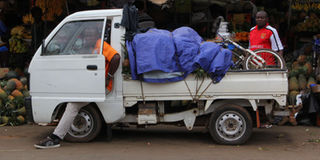Shopping baskets with a fuel friendly engine

A microvan populary known as Nyongeza, Luganda for ‘additional’ is parked in a way that suggests, it is about to be loaded with merchandise. These small trucks are very economical and easy to park, thanks to their sizes. Photo By Ismail Kezaala
What you need to know:
It looks so small you may call it a baby truck, but it is fast becoming a must-have for not so demanding errands. Walk by Nakasero market and chances are that you will “bump” into a Nyogeza pick-up. Here, traders use them to carry shoppers’ goods, ranging from electricals to hardware. But how did they get here in the first place?
You might be one of the lot that have heard the tale but taken it for a joke. When it is narrated, one of the questions that run through your mind is, who gives out a car for free? Well, have no doubt again, seeing that reliable sources verified the story’s authenticity. It is true that the carry trucks alias “nyongezas” alias “shopping baskets”, used to be given for free or as a token of appreciation.
Tracing their history
Isaac Kabonge, a beneficiary of the free carry trucks’ bonanza, who has been importing cars from Japan since the 90s, says that he received his first one in 1998. “During that business trip, I bought four cars and I was given the ‘nyongeza’. More trucks were given to me on my recurring trips whenever I bought more than three cars. Of course this offer was not made by all companies. My colleagues who imported spare parts also did not miss out on the free ‘shopping baskets’.
“One who made sizeable purchases would be granted the car. The goods would be loaded onto the truck and driven to the shipping company of one’s choice,” narrates Kabonge. The car importer says that then, a paltry Shs400,000 was paid in taxes for the cars. He adds that while some traders sold off theirs, others (especially those who dealt in spare parts) kept them and used them to run errands between their stores and shops.
“Those who sold them did so at prices ranging between Shs 1.2m to Shs1.5m. However, their market was low because folks despised them and often made derogatory remarks such as, ani agula enyongeza which means “who buys a token?” That was the genesis of the carry trucks’ popular name “nyongezza”. Others used not to buy them because they preferred the Nissan Sunny Truck which is more durable,” states Kabonge
Not free anymore
Simon Wanzara, a worker at Japan Auto, a car bond in Nakawa, says that giving the carry truck, freely, stopped around 2003. He says that the number of businessmen who were flying to Japan to buy cars and their spare parts increased, so, it was no longer cost effective for the Japanese to offer them freely.
According to Wanzara, today, a new carry truck ranges between Shs13 to Shs12m while a used one which is in a good condition ranges between Shs8m to Shs7m. It is one of the multipurpose cars on the market made by a number of manufacturers such as Suzuki Carry, Mazda Scrum, Daihatsu Hijet, Mitsubishi Minicab, Honda Acty, Suzuki Every, Suzuki Super, Daewoo Damas, Landy, Maruti Versa, and Subaru Sambar.
Musa Ssebi, who owns one, says that he hires his “shopping basket” to ferry goods from people’s shops to the destination of the customers’ choice and, that it can carry up to 1,000kgs. “I also use it to move around with my family. Its fuel consumption is enviable.
With an engine of 900cc it consumes 1 litre for 10km. It is easy to maintain since its spare parts are readily available and affordable.” Others have even smaller engines of 660cc and most of them are of manual tranmission.
Challenges
Of its cons, Ssebi says that it has a limited passenger capacity. “It is licensed to carry two passengers. The height of these passengers matters because if they are very tall they may not fit in or they will, but travel uncomfortably. It loses its stability on the road depending on the quality of the road – the smoother the road, the better. Also, it becomes lighter as one increases the speed they are driving at.”




